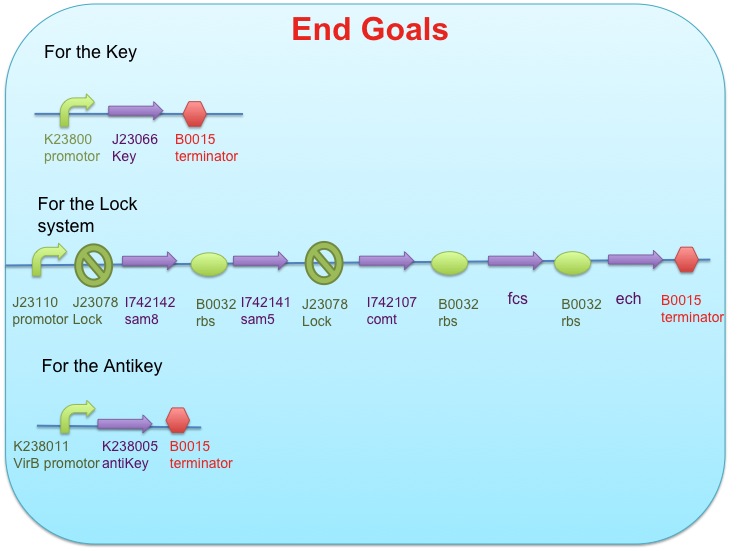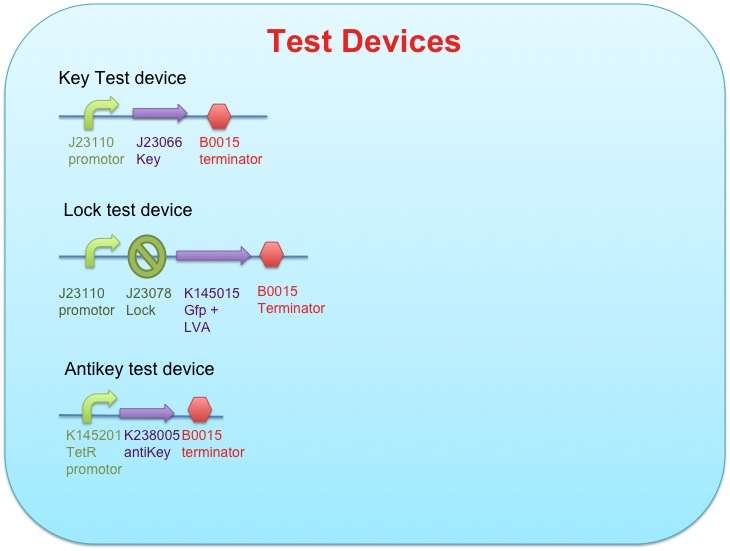Team:KULeuven/Wetlab/Key Antikey
From 2009.igem.org
Bart Bosmans (Talk | contribs) |
|||
| Line 3: | Line 3: | ||
{{Team:KULeuven/Common2/EndHeader}} | {{Team:KULeuven/Common2/EndHeader}} | ||
__NOTOC__ | __NOTOC__ | ||
| - | =Key | + | =Key Lock AntiKey: Planning= |
==Goal== | ==Goal== | ||
We want to test the affinity of the Key for the Lock and measure the amount of input signals needed to activate transcription. On the other hand, we want to test the effect of adding the Antikey at the level of transcription. | We want to test the affinity of the Key for the Lock and measure the amount of input signals needed to activate transcription. On the other hand, we want to test the effect of adding the Antikey at the level of transcription. | ||
Latest revision as of 07:38, 12 October 2009
Key Lock AntiKey: Planning
Goal
We want to test the affinity of the Key for the Lock and measure the amount of input signals needed to activate transcription. On the other hand, we want to test the effect of adding the Antikey at the level of transcription.
First, we will prepare the test devices for the Key and Lock. Both Key and Lock are made constitutively. If GFP is present, we know the Key works. The system doesn't need more rigorous testing, since last year’s team already did this. If we thereupon add the Antikey device, we can measure how the rate of transcription lowers, depending on the amount of tetracycline added.
Required
- Biobricks:
For the Key device
- + : The Key sequence with terminator is ordered at GeneArt.
- Promotor, plasmid present in the lab.
- Restriction enzymes EcoRI, XbaI and SpeI
- K12 E. Coli strains ( No special needs)
For the Lock device
- Promotor, plasmid present in the lab
- Lock Sequence is ordered at GeneArt
- + : GFP + LVA part present in the lab with terminator attached
For the AntiKey device
- TetR promotor, present in the lab
- + : Ordered at GeneArt
Steps
• First, all plasmids still present in the lab need to be isolated, so they’re ready to use. Then the GeneArt sequence of the Key can be ligated in the promotor plasmid.
• Next, the promotor can be ligated to the GeneArt Lock sequence. If that’s done, the + construct can be ligated to the promotor/Lock sequence.
• These constructed plasmids can then be electroporated into the K12 E. coli cells and a GFP assay can be done to check if the Key/Lock system works properly. At this moment, we also need to measure the intensity or rate of fluorescence, in order to verify later if the Antikey works.
• At the same time the promotor can be ligated to the AntiKey GeneArt sequence, making the Antikey device.
• In order to test the Antikey, all 3 plasmids need to be electroporated into the E.coli strains. Important is that all 3 plasmids contain a different control system (LacZ, Ampicillin or Kanamycin), so we can be sure the strains contain all three plasmids.
• By comparing the GFP results with and without Antikey, we can investigate whether our Antikey has an effect on the transcription of GFP.
Important
I. Always make sure you never cut with an illegal restriction enzyme.
II. Make sure the plates you grow the bacteria on contain the right antibiotic.
III. You should always be able to identify not only the transformed colonies, but more importantly the recombinant colonies. This can be done by putting all three vectors in the cell or by combining two devices on one plasmid.
 "
"









